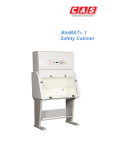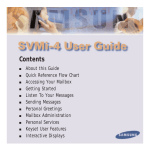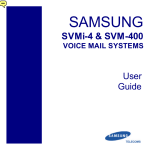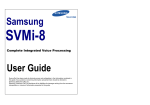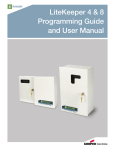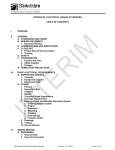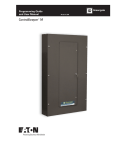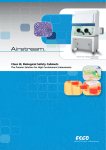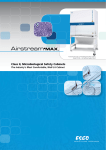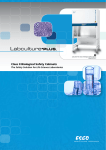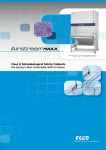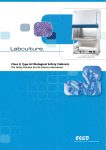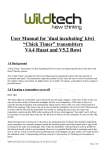Download Horizontal Laminar Flow Cabinet
Transcript
Horizontal Laminar Flow Cabinet Contained Air Solutions Ltd | Unit 4 Greengate | Middleton Junction | Manchester M24 1RU | T +44 (0)161-655-8860 | F +44 (0)161-655-8865 [email protected] | www.containedairsolutions.co.uk We reserve the right to change specification without notice. © 2009 Contained Air Solutions Ltd Contents Section Description Section 1 Your Manual Section 2 Using your Cabinet Section 3 Cabinet Control Panel Section 4 Filter Replacement Section 5 Service & Spares 1.1 1.2 1.3 1.4 1.5 General Description Quality Assurance/CE compatibility Installation Technical Data Your Manual 2.1 2.2 2.3 2.4 2.5 Switches & Indicators Start Up Procedure Shut Down Procedure Cleaning Procedure Ultraviolet Radiation 3.1 3.2 3.3 3.4 3.5 Display Alarm Circuits Electrical Protection Fan Speed Control Engineers Menu 4.1 4.2 4.3 HEPA Filter Pre-Filter General Notes 5.1 5.2 5.3 Service Schedule Spares List Drawing (attached) General Description – 1.1 C.A.S. Horizontal Laminar Flow Workstations are designed to provide a localised clean air area, for manipulations that require a particle free or sterile environment. The unit carcase is manufactured from mild steel with a white epoxy coating to give a hard durable finish. The working surface is stainless steel to resist scratches and abrasion and to be free from discolouration by chemicals. Fluorescent lighting illuminates the working area. The latest in microprocessor and fan technology is utilised to exceed the performance requirements of the European Standard BSEN 14644 Class 3, 4 or 5 and EC GMP Grade A Class F to BS 5295 Class 100 (Federal Standard 209E) It should be remembered that CAS Horizontal Laminar Flow Workstations direct the air from the work towards the operator. They must therefore not be used for work involving any materials that can produce biological or chemical hazards to the worker. For protection against such hazards Contained Air Solutions Limited produces a range of Microbiological and Pharmaceutical Safety Cabinets. This user manual has been prepared to give basic operating and maintenance instructions. It is only ever intended to supplement existing in-house procedures and not to replace them. If further advice on the use of this equipment is required, Contained Air Solutions Limited will be pleased to assist where possible. Quality Assurance – 1.2 Although fully tested before leaving our factory as part of the ISO 9001:2008 Quality Assurance Programme, the specified performance will only be maintained if your cabinet is sited correctly and regularly serviced. CAS can only accept responsibility for correct functioning of your cabinet if: Ø The cabinet is correctly sited in the laboratory to avoid any adverse conditions within the room that may affect the level of protection. Ø It has been installed and commissioned by CAS trained personnel or approved CAS agents. Ø Extension, modification, relocation, repairs or other maintenance is carried out by CAS personnel or persons authorised by CAS or, in the case of electrical work, by qualified electricians. Ø In the case of repair or maintenance, replacement parts supplied by CAS must be used. Ø The electrical installation surrounding the unit and to which it is connected comply with the latest IEC regulations. Ø The unit is used and maintained in compliance with the instructions contained in this manual. CE Declaration of Conformity CAS declares that the equipment supplied conforms to the following CE directives— Machinery 2006/42/EC Electro Magnetic Compatibility 2004/108/EC Low Voltage 2006/95/EC Installation – 1.3 Horizontal Laminar Flow cabinets are sophisticated items of equipment containing delicate filters which require expertise in their safe handling and installation into laboratories. A poorly installed cabinet may compromise the protection provided by the cabinet to work being handled. · Commissioning (On site optional extra) When any cabinet is installed, it is necessary to carry out a number of commissioning checks in order to ensure it is fully operational and that the performance on site satisfies the current standard BS EN 14644 Class 3, 4 or 5. This includes testing the HEPA filters with a suitable challenge aerosol and a particle count test to assess the cleanliness of the cabinet. CAS employs a team of fully trained installation and commission engineers to carry out all work necessary. This ensures that all new HLF cabinets operate to the desired performance. · Site Surveys If you have any queries regarding the siting of your HLF cabinets we will be only too pleased to arrange a site survey by one of our regionally based technical support staff. · Periodic Maintenance & Servicing To maintain HLF cabinets at their optimum level of performance and to ensure lifetime operation, regular servicing is necessary. CAS provides a full servicing and maintenance scheme tailored to suit your individual needs. For more information on this please contact our service department on 0161-655-8860. Technical Data – 1.4 Cabinet Size Dimensions External Dimensions Internal Dimensions Work Tray 1200mm (w/d/h) (w/d/h) (w/d) 1200/750/1302 1100/500/730 1100/500 Weight Typical Kg 200 Loading Capacity Work Surface Kg 50 m/sec 0.45 Pa Pa 250 350 HEPA Filter Data HEPA Type Efficiency @ 0.3µ H14 (EN1822) 99.999% Heat Gains Typical Recirc Watts 500 Noise Typical Noise Level dB (A) <60 Light Typical Interior Lux 800 Volts AC Hz N/A kW A 230 Air Velocity Typical Air Velocity Pressure Drop Typical Clean Filters Dirty Filters Electrical Data Typical Voltage Frequency Phase Power Consumption Current Internal Socket 50 Single 0.70 4 230v /13 Amp Your Manual – 1.5 This user manual has been prepared to provide a basic operating and maintenance instruction. It is intended to supplement existing in-house procedures and codes of practice, and not to replace them. If further advice is required on the use or maintenance of this equipment, the staff of Contained Air Solutions Ltd. will be pleased to assist wherever possible. Switches & Indicators – 2.1 The diagram below shows a typical control panel membrane layout for the HLF cabinet. 0 LAMINAR FLOW CAS 1 DESCRIPTION LEGEND COLOUR FUNCTION A – Cabinet Operation Green Starts / Stops power supply to fans and control circuits. B – Lights Yellow Controlling power to lights. C – Gas Valve (NOT APPLICABLE) Black D – Alarm Mute Red E – Fumigate (NOT APPLICABLE) Orange F – UV Lights (Optional) Blue 0 G – Key Switch To mute audible alarm. Fault indication on display will remain until fault is rectified. 1 Grey Border To activate power to UV Lights. Will only operate when cabinet and lights are switched OFF. Key switch for supervisor control, used to prevent cabinet operation. Start Up Procedure – 2.2 The following notes are for guidance where local laboratory instructions do not exist or are inappropriate. They should complement, not replace, existing codes of practice issued by your Laboratory Safety Officers. Ø Ensure power supply to the cabinet is switched on, as evidenced by the main display being illuminated. The key switch on the front of the cabinet must be turned to position ‘1’ = (ON). Ø Press the green switch ‘A’ on the control panel – this will energise the integral fan. The main display will show `AIRFLOW STABILISING` for 60 seconds, once the airflow is settled the display will show `LAMINAR FLOW AIRFLOW SAFE`. On start up the audible alarm will sound until airflows are safe; this may be muted using the Alarm Mute switch `D’. Ø Switch on the interior lighting using switch ‘B’. Lighting can be activated when the cabinet is OFF; this can be used if loading or un-loading the cabinet with equipment prior to use. Shut Down Procedure – 2.3 Ø The work area should be cleared of any apparatus / equipment and cleaned in accordance with laboratory codes of practice. The cabinet should be left running for a few minutes to clear any residual aerosols. Ø Switch off the interior light using switch `B` Ø Switch off the cabinet using switch `A`. Cleaning Procedure – 2.4 Regular cleaning is very important to prevent the build-up of dirt and hence potentially infectious material. Routine swabbing of work surfaces with 70% v/v IMS (ethanol) or IPA (Isopropyl Alcohol) is recommended. For cleaning the work surfaces, swabbing with a mild detergent in warm water is very effective. Phenolic or Cresolic disinfectants should be avoided as they may stain the white surfaces with a brownish colour. If they are used, any spillage should be quickly rinsed with clean water and mopped up with an absorbent tissue. Most of the quaternary ammonium compounds and the Glutaraldehyde based surface disinfectants are suitable. NOTE: The rear wall of the working area is formed by the HEPA filter. Although protected by a metal mesh, care must be taken not to damage the filter membrane, and splashing it should be avoided if possible. If the protective grille has become soiled it may be cleaned by gently wiping with a damp cloth. If Hypochlorites are used to clean the stainless steel of the cabinet they will initially cause rust spots and over time may lead to further damage. Warning Ultraviolet Radiation (Optional) – 2.5 Ultraviolet Radiation (UV) lamps may be fitted as an optional extra; these can be fitted as new in our factory or retrofitted at a later date on site. If installed the cabinet will have 2 short wavelength Ultraviolet (UV) tubes emitting 254 nano metres fitted inside the work area of the cabinet. As a safety feature the UV tubes are interlinked with the cabinet lights to prevent them being used when the cabinet is in use. Over time, the effective life of UV tubes is known to reduce; therefore we would recommend UV tubes are replaced on an annual basis to ensure maximum efficiency. Applications Many bacteria are quite resistant to UV Radiation, and may require prolonged exposure for sterilisation. Dry and/or protein covered organisms may be protected against UV and may be only slightly affected if at all. However, moist, vegetative cells without too much protein covering are killed with reasonable effectiveness after 3-4 hours exposure. Extreme care must be exercised when using UV radiation. Consult your Laboratory Safety Officer prior to use. Warning UV Radiation can cause burns to unprotected skin and it is very important not to look directly at the illuminated tubes with the naked eye. Display - 3.1 The cabinet display is located in the centre of the control membrane; it incorporates backlighting to ensure all signs can be clearly seen from the operating position. Typical display during normal operation shown below: LAMINAR FLOW AIRFLOW SAFE In the event of an alarm condition the display will clearly indicate the fault; this will remain displayed until the fault is rectified. Typical display during alarm condition shown below: LO W A IR FLO W Should the cabinet produce an alarm condition it may be necessary to arrange for a Service Engineer to attend site, in such cases please contact our Service Department on 0161-6556183. Alarm Circuits – 3.2 There is only one standard alarm circuit on the Horizontal Laminar Flow cabinet. 1. AIRFLOW Sensed by an accurate pressure sensor mounted on the main printed circuit board and connected via tubing to the sensing points within the cabinet body, this will sense low airflow caused by fan failure or filter soiling, and transmit the signal to the display meter on the front panel and alarm circuit. In the event the alarm is triggered the display will show `LOW AIRFLOW`, and the audible alarm will sound, this can be muted using the alarm mute button. ** The alarm circuit is activated each time the cabinet is switched on. It is important to ensure that the pressure tubing is not damaged or split where it is connected to the pressure sensor. The pressure sensor, in the event of inadequate airflow in either part of the system, will cause the alarm circuit to be activated with a flashing red indicator on the alarm mute button, an intermittent audible alarm tone, and the alarm system will clearly show on the display. The audible alarm tone can be silenced by depressing the ‘alarm mute’ button on the control panel after which the red light will remain continuously lit until the correct airflow is reinstated or the cabinet is switched off. Electrical Protection – 3.3 Ensure the Safety Cabinet is isolated from the mains supply prior to opening access panels. Warning Fuses There is one fuse mounted on the printed circuit board to protect the electrical circuits of the cabinet. The cabinet controls are housed behind the front control panel which is secured with two screws located across the bottom edge. Once removed the control panel will hinge upwards to facilitate access to the main printed circuit board. For full details on fuse rating and the circuits it protects please see the wiring diagram attached to this manual. Fan Speed Control – 3.4 The fan can be adjusted via the engineer’s menu please see section 3.5 for more information. To maintain optimum performance during routine planned maintenance it may be necessary to increase cabinet fan speed to overcome filter soiling. This can be adjusted via the front control panel membrane using the Engineer’s Menu. It is important any changes to fan speed must be made by a CAS service engineer or alternative competent service provider, failure to do this may result in the warranty being invalid. Warning Engineer’s Menu – 3.5 It is important that any changes within the Engineer’s Menu be conducted by a CAS service engineer or alternative competent service provider; failure to do so may result in the warranty being invalid. Warning The buttons located on the front control membrane have a second function once access to the Engineer’s Menu has been gained. ** In order to gain access to the Engineer’s Menu the cabinet must be switched OFF ** STANDARD SWITCH PANEL ARRANGEMENT SOFT BUTTON ARRANGEMENT TO ENTER `ENGINEERS MENU` BUTTON 1 SHOULD HELD DOWN FOR >5 SECONDS TO EXIT `ENGINEERS MENU` BUTTON 1 SHOULD HELD DOWN FOR >5 SECONDS USE BUTTON 2 TO START / STOP THE FANS Engineer’s Menu Sequence LO W A LA R M 4 0 Pa Y ES NO FA N S PE ED 40 % Y ES NO U .V . LIG H T IN G 0 6 0 M IN UT E S Y ES NO HOURS RUN 08 HRS Y ES NO C LE AR H O UR S R UN Y ES INIT IAL IS E V AL UE Y ES INIT IA LIS E (0 ) HEPA Filter – 4.1 The single HEPA filter is mounted immediately behind the working area. Access is gained by removing the rear access panel, held in place by screws. The filter and air equalisation plate is retained by screwed clamps. When these are released the plate and used filter can be pulled free and removed. The frame surfaces should be cleaned carefully and any grit particles removed. The new filter gasket should be lightly greased with Dow Corning silicone grease or similar prior to being placed in position. The clamps should be replaced and tightened so as to compress the gaskets by about one third. Care must be exercised not to over-tighten and over compress the gasket. The access panel must then be replaced after ensuring its gasket is in good condition. IMPORTANT Cabinet must be decontaminated prior to changing any HEPA filters, see section 2.6 Only replace or examine filters if authorised to do so by the Safety Officer or the person in charge of the laboratory. To remove any filters wear disposable gloves, an apron, overalls and appropriate face covering, especially eye protection. Ensure the cabinet is isolated from the mains supply prior to opening access panels. Warning Pre-Filter – 4.2 The pre-filter pads are located at the top of the cabinet and simply drop into place on their retaining frame. The pre-filter pads should be examined frequently (Once each month) for heavy soiling and replaced on a regular basis to prolong the life of the main HEPA filter. IMPORTANT Only replace or examine filters if authorised to do so by the Safety Officer or the person in charge of the laboratory. To remove any filters wear disposable gloves, an apron, overalls and appropriate face covering, especially eye protection. Ensure the cabinet is isolated from the mains supply prior to opening access panels. Warning General Notes – 4.3 Ø The amount of equipment stored in the cabinet should be kept to a minimum to reduce the disruption to the airflow patterns within the cabinet. Ø A Bunsen burner should not be used inside the cabinet. Ø The failsafe solenoid operated gas valve (If fitted) will only allow gas to flow when the cabinet is switched on and there is a satisfactory airflow. Any interruption in the power supply or failure of air supply necessitates manual resetting of the valve by depressing the switch on the control panel marked ‘gas valve’. Ø As a safety feature the UV tubes (If fitted) are interlinked with the cabinet lights to prevent them being used when the cabinet is in use. We recommend cabinet users to consult their own laboratory safety information. Other publications available include: Science Reviews Ltd, Occupational Hygiene Monograph No.9 British Standard BS EN 12469:2000 & 5726-2000 Part 5 Australian Standard AS2567 American National Sanitation Foundation Standard No. 49 We would also recommend the latest guidelines issued by the UK Advisory Committee on Dangerous Pathogens (ACDP). These documents contain much useful information on the performance, installation, testing, use and limitations of laminar flow cabinets. Service Schedule 5.1 SERVICE SCHEDULE 5.1 Horizontal Laminar Flow Cabinets Schedule of work included in service agreement 1 Filter Integrity Test (D.O.P) on all main filter(s) and seals 2 Airflow Profiling ensuring compliance to latest British & European Standards 3 Check and adjust alarm parameters & control functions as required 4 Air cleanliness test within work zone (particle counts) 5 Check and adjust electrical and electronic controls as related to the airflow system 6 Mechanically inspect cabinet components 7 Change main filters as necessary (Supply and fitting subject to additional charge) 8 Prepare computer generated Service Report Above work to be carried out twice each service year Spares List 5.2 Shown below are ordering codes for the most common parts used on the Horizontal Laminar Flow cabinets. In addition to these items we stock a vast range of Spares, consumables and optional extras. If you cannot see what you require please give us a call on the telephone number shown below. ** Please note cabinet serial number must be quoted when ordering ** ORDERING CODES Item HLF 1200mm HEPA Filter 112575566 Pre-Filter 30/30G4 49729347 Fan FAN 030 Main PCB ELC 346 Control Membrane LAB 114 Light Tube ELC 077 UV Light Tube (Optional) ELC 061 Key Switch ELC 199























